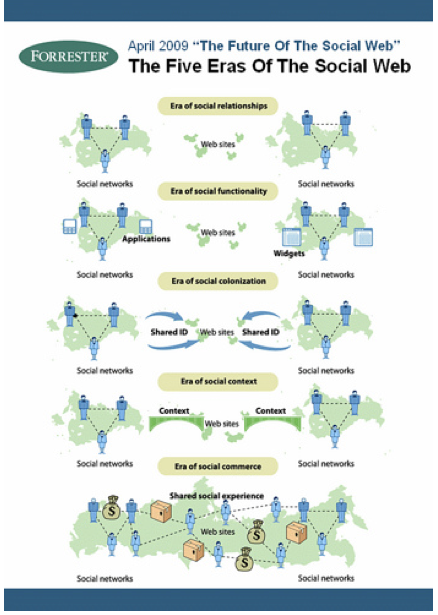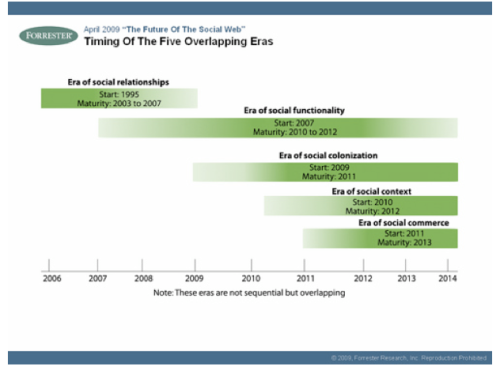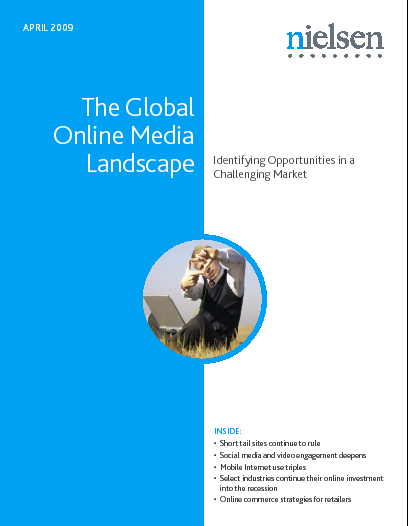About a month ago, Forrester Research released a new report, authored by Jeremiah Owyang, on the future of the social web.
The other day, Jeremiah, inspired by a trip he made to the Netherlands, put out a call to the international social media community to translate his abstract of the study into foreign languages. You can find the original English here, and my translation into German below.
DIE ZUKUNFT DES SOZIALEN NETZES: IN FÜNF EPOCHEN
Post vom 27. April 2009
Erwarten Sie, dass das Phänomen des Groundswells, in dem Menschen sich online eher miteinander verbinden, als mit Institutionen, sich fortsetzt. Der Teilnahme des Verbrauchers an sozialen Netzwerken nimmt rasant zu, immer mehr Marken spielen auch während der Rezession mit. Von daher wird der Raum sich ständig neu entwickeln, um mit diesem Trend mitzuhalten. Kunden haben Zugang zu diesem Bericht, aber um die Ergebnisse zusammenzufassen, schreiben wir eine kurze Inhaltsangabe:
Das Erleben des sozialen Internets ist heute ziemlich wirr und zusammenhanglos, weil der Verbraucher für jeden sozialen Netzwerk, das er besucht, ein anderes Profil braucht. Einfache Technologien werden den Verbraucher es bald ermöglichen, dasselbe Profil überallhin mitzunehmen und dies wird zu einer Verwandlung von Marketing, eCommerce, CRM und Werbung führen. IDs sind nur der Anfang dieser Verwandlung, bei der das Netz sich von getrennten sozialen Ortschaften hin zu einem gemeinsamen Erlebnis umwandeln wird. Verbraucher werden sich auf ihresgleichen verlassen, um Online-Entscheidungen zu treffen, egal ob Marken sich vorziehen, daran teilzunehmen oder nicht. Miteinander verbundenen Verbraucher werden Online-Communities verstärken und die Macht weg von den Marken und CRM hin zu diesen Communities verlegen. Schließlich werden diese ermächtigten Gemeinschaften die nächste Generation von Produkten bestimmen.
Wir stellten fest, dass neue Technologien Änderungen im Verhalten des Verbrauchers auslösen, und die Marken werden folgen. Daraus ergibt sich fünf eindeutigen Wellen:
Die Fünf Epochen des Sozialen Netzes
1) Die Epoche der sozialen Beziehungen: Menschen verbinden sich und tauschen Gedenken und Erfahrungen aus
2) Die Epoche der sozialen Funktionalität: Soziale Netzwerke sind wie Betriebssysteme
3) Die Epoche der sozialen Besiedlung: jedes Erlebnis kann nun sozial sein
4) Die Epoche des sozialen Zusammenhangs: individueller und zutreffender Inhalt
5) Die Epoche des sozialen Handels: Communities bestimmen zukünftige Produkte und Dienstleistungen

Zeitablauf der fünf sich überschneidenden Epochen
Es ist wichtig zu erwähnen, dass das keine aufeinander folgenden Epochen sind, sondern sie überschneiden sich. Die Epoche der sozialen Beziehungen ist schon weit fortgeschritten. Die Epoche der sozialer Funktionalität hat schon begonnen, obwohl wir hier noch keine echte Nützlichkeit bis jetzt erlebt haben. Und die ersten Zeichen von sozialer Besiedlung sehen wir in frühen Technologien wie Facebook connect. Bald werden übergreifende Identitäten den Menschen es ermöglichen, in die Epoche des sozialen Zusammenhangs mit individueller und zutreffender Inhalt einzutreten. Das folgende Schaubild zeigt, wie die Epochen in Zukunft sich entfalten könnten — die Epoche des sozialen Handels folgt dann zuletzt.

Gespräche mit 24 der führenden sozialen Gesellschaften
Die Forschung läuft nicht einfach im Labor ab. Deshalb haben wir qualitative Marktforschung durchgeführt, um herauszufinden, was zu erwarten ist. Wir sind zu diesen Schlussfolgerungen durch Gespräche mit Geschäftsführern, Produkt Managern und Strategen in den folgenden 24 Firmen: Appirio, Cisco Eos, Dell, Facebook, Federated Media Publishing, Flock, Gigya, Google (Open Social/stack team), Graphing Social Patterns (Dave McClure), IBM (SOA Team), Intel (social media marketing team), KickApps, LinkedIn, Meebo, Microsoft (Live team), MySpace, OpenID Foundation (Chris Messina), Plaxo, Pluck, Razorfish, ReadWriteWeb, salesforce.com, Six Apart, and Twitter.
Wie Marken sich vorbereiten sollen
- Nicht zögern: diese Veränderungen kommen schnell auf uns zu und bis Ende des Jahres werden wir schon die ersten drei Epochen erleben. Marken sollten sich darauf einstellen, in dem sie diese Epochen in ihrer kurzfristigen Planung Rechnung tragen. Lassen Sie sich nicht hinterher laufen, während der Konkurrenz Beziehung zu Ihrem Community aufbaut, bevor Sie es tun.
- Bereiten Sie sich auf Transparenz vor: Die Menschen werden den Netz zusammen mit ihren Freunden surfen. Von daher brauchen Sie einen Plan. Bereiten Sie sich darauf vor, dass Ihre Kunden über jede Webseite und jedes Produkt von Ihnen berichten und diese Berichte von Kaufinteressanten gesehen werden, auch wenn Sie sich es vorziehen, nicht daran teilzunehmen.
- Suchen Sie Kontakt mit Ihren Befürwortern: setzen Sie die Priorität auf sie. Sie werden Kaufinteressanten überzeugen und Sie gegen Kritiker verteidigen. Sie sind glaubwürdiger als Sie es sind, und wenn die Macht sich auf das Community verlegt wird und die Mitglieder der Gemeinschaft immer mehr über Produktpolitik bestimmen, werden sie wichtiger sein als je zuvor.
- Entwickeln Sie Ihre Unternehmenssysteme weiter: Ihre Unternehmenssysteme müssen sich mit dem sozialen Netz verbinden. Soziale Netzwerke und ihre Partner verwandeln sich schnell zur Quelle von Information und Kaufinteressanten zusätzlich zu Ihrem CRM-System. CMS-Systeme werden soziale Eigenschaften annehmen müssen. Fordern sie das von ihren Lieferanten oder finden Sie ein Community-Platform.
- Zerschlagen Sie die Website Ihres Unternehmens: Im radikalsten Zukunftsbild wird Inhalt den Weg zum Verbraucher finden müssen, nicht andersherum. Lassen Sie Ihre Website in Fragmenten aufbauen und diese Fragmente im sozialen Web sich verteilen. Setzen Sie die wichtigsten Informationen frei und lassen sie unter den Communities ausbreiten, wo diese sich befinden. Der Fischer fischt da, wo die Fische schwimmen.






